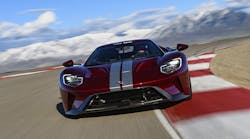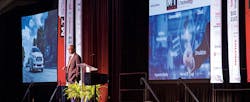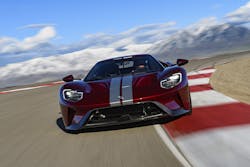Sneak Peek: Ford Shares Plan for the Automotive Technology Future
Carmakers have a host of new technologies available now, and a seemingly limitless amount of options are evolving to provide future options. Most people assume that these options will be limited to the high-end luxury-vehicle market or cutting-edge vehicles like the Tesla line. However, Ford’s SYNC—now in at least its third iteration—has already highlighted the company’s efforts to provide ease of use with technology applications and tools early on, ranging from running a linked cellular device through the center-console display to voice-recognition systems for maps, etc. In a keynote address at the Manufacturing & Technology Expo, Ken Washington, vice president, Research and Advanced Engineering at Ford Motor Co., touched on how Ford plans to similarly make available better vehicles and a vehicle experience via data analytics, the Internet of Things, virtual reality, robotics, and additive manufacturing.
Washington credited the original innovative Henry Ford as the company’s inspiration today, saying “Henry Ford put the world on wheels.” Indeed, Ford was the first to provide a $5/day wage in the United States, creating a class of workers who could afford to buy the product they made. The company plans to continue to be a company of “firsts” that are needed by society and in the car industry by focusing its efforts on the following areas while working nimbly to leverage “the power of the startup economy” around automotive right now:
1. Material/manufacturing innovations: Ford is looking to apply additive manufacturing/3D printing by partnering with Stratasys to apply this technology on a large scale via a very large-scale 3D printer. In doing so, Washington noted that Ford is exploring a future where a car will be customized to the individual driver and passenger. They are also looking to light-weight their vehicles via additive manufacturing. In terms of light-weighting, Ford already is using a high-strength aluminum body on some vehicles. For example, the Ford GT350 high-performance vehicle uses carbon fiber wheel, reducing weight to improve performance and acceleration.
This all-new, race-winning Ford GT supercar serves as a test bed for new technologies and advanced lightweight materials. For example, carbon fiber helps the GT achieve weight savings and sleek body shapes in ways that are not possible with steel or aluminum.
2. Sustainability: Taking an Earth-friendly approach, Ford’s EcoBoost translates into direct gas savings. The firm also has a team investigating natural materials and their potential application in its vehicles, such as soybeans, agave, nectar, and recycled bottles. By combining bamboo and plastic, for example, the researchers have discovered that they can create extra-strong parts. The company also recycles aluminum on a large scale.
3. Urban Megatrends: Ford is looking ahead to address the four major megatrends it sees in the future: urbanization, which will lead to crowded mega-cities; expansion of middle class globally; air-quality concerns; and changing consumer attitudes due to everyone being connected. Ford sees these aspects disrupting not only the design and manufacturing of cars, SUVs, and trucks, but also leading to emerging mobility services and solutions.
4. Autonomous vehicles: Washington sees vehicle autonomy as “as important a shift in the automotive industry as the moving assembly line.” At Level 4 autonomy, no driver is required within a defined geographic area. The deployment of such vehicles can ease the strain of rapidly expanding urban environments, noted Washington. He believes that autonomous vehicles will first become popular not for individual consumers owning vehicles, but in the market for transportation as a service (taxis, Uber, etc.). An autonomous vehicle could handle deliveries and other goods handling beyond helping people travel. With the acquisition of Chariot, which has smart vans, Ford is already enabling ride-sharing in San Francisco and Austin, Texas. It will roll out in eight more cities this year.
5. Software: Combine this capability together with increasing data analytics from vehicles and vehicle-to-vehicle networking, and it’s no surprise that Washington says, “Building software capability is critical.” Ford has brought on more than 400 software engineers this year and plans to grow that number. They are helping to develop and support the latest Ford software innovations, such as SYNC Connect and the free FordPass app, which allows users to lock their car, find it in a parking lot, etc. using their smartphone.
6. Electrification: Washington revealed Ford’s plans to release 13 new global electrified vehicles in the next five years. Among these are an F-150 hybrid, Mustang, police pursuit vehicles, a small utility battery electric vehicles (with a range of at least 300 miles), and a new fully autonomous hybrid vehicle built in the USA. Noting the need to improve ease of charge, Washington mentioned that Ford is teaming with BMW, Daimler, and Volkswagen to deliver 350-kW charging power at charging stations throughout Europe. Their goal is to make battery-powered EVs attractive to everyone.
When it comes to people’s concerns over autonomous vehicles, Washington pointed out that we shouldn’t think of autonomous vehicles as people-driven vehicles, because most accidents are caused by people making bad judgments. Instead, we should think of those vehicles as removing the human element and the problems that humans are very bad at solving. As a result, the autonomous vehicles will only have to deal with challenges like mechanical failures, acts of God, and natural disasters. In closing, however, he noted that the industry is working to standardize this, realizing that autonomous cars at some point will have this dilemma: How do you make a decision when there is no good decision to be made?



